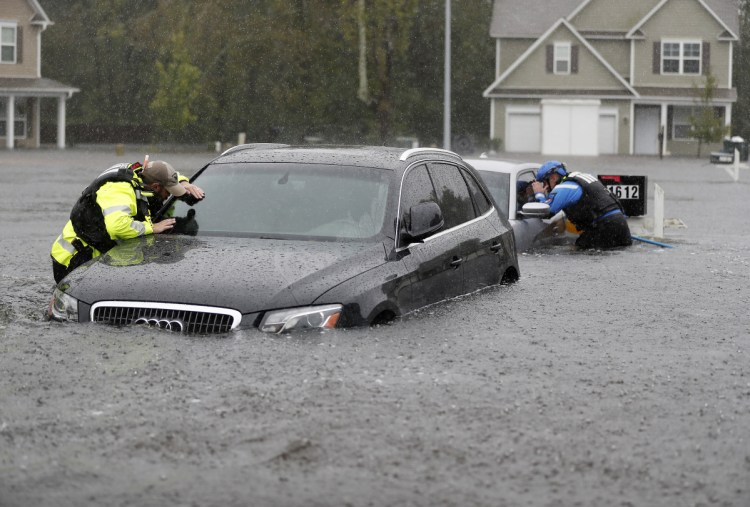WILMINGTON, N.C. — Catastrophic flooding from Florence spread across the Carolinas on Sunday, with roads to Wilmington cut off by the epic deluge and muddy river water swamping entire neighborhoods miles inland.
“The risk to life is rising with the angry waters,” Gov. Roy Cooper declared as the storm’s death toll climbed to 16.
Florence continued to crawl westward, dumping more than 30 inches of rain in spots since Friday, and fears of historic flooding grew.
Tens of thousands were ordered evacuated from communities along the state’s steadily rising rivers – with the Cape Fear, Little River, Lumber, Waccamaw and Pee Dee rivers all projected to burst their banks.
In Wilmington, with roads leading in and out of the city underwater and streams still swelling upward, residents waited for hours outside stores and restaurants for basic necessities like water. Police guarded the door of one store, and only 10 people were allowed inside at a time.
Woody White, chairman of the board of commissioners of New Hanover County, said officials were planning for food and water to be flown into the coastal city of nearly 120,000 people.
About 70 miles away from the coast, residents near the Lumber River stepped from their homes directly into boats floating in their front yards; river forecasts showed the scene could be repeated in towns as far as 250 miles inland as waters rise for days.
Downgraded overnight to a tropical depression, Florence was still massive. Radar showed parts of the sprawling storm over six states, with North and South Carolina in the bull’s-eye.
The storm’s death toll reached 16 when a pickup truck ran into standing water in South Carolina and the driver lost control, hitting a tree, authorities said. Two other people also died in storm-related wrecks, and two more died from inhaling carbon monoxide from a generator in their home.
As rivers swelled, state regulators and environmental groups were monitoring the threat from gigantic hog and poultry farms located in low-lying, flood-prone areas.
The industrial-scale farms contain vast pits of animal feces and urine that can pose a significant pollution threat if they are breached or inundated by floodwaters. In past hurricanes, flooding at dozens of farms also left hundreds of thousands of dead hogs, chickens and other decomposing livestock bobbing in floodwaters.
Stream gauges across the region showed water levels rising steadily, with forecasts calling for rivers to crest Sunday and Monday at or near record levels. The Defense Department said about 13,500 military personnel had been assigned to help relief efforts.
Authorities ordered the immediate evacuation of up to 7,500 people living within a mile of a stretch of the Cape Fear River and the Little River, about 100 miles from the North Carolina coast. The evacuation zone included part of the city of Fayetteville, population 200,000.
Duke Energy said heavy rains caused a slope to collapse at a coal ash landfill at a closed power station outside Wilmington late Saturday, but there was no indication contamination had drained into the nearby Cape Fear River.
Near the flooded-out town of New Bern , where about 455 people had to be rescued from the swirling flood waters, water completely surrounded churches, businesses and homes. In the neighboring town of Trenton, downtown streets were turned into creeks full of brown water.
The rain was unrelenting in Cheraw, a town of about 6,000 people in northeastern South Carolina. Streets were flooded and Police Chief Keith Thomas warned people not to drive, but the local food and gas store had customers.
“As you can tell, they’re not listening to me,” he said.
Send questions/comments to the editors.



Success. Please wait for the page to reload. If the page does not reload within 5 seconds, please refresh the page.
Enter your email and password to access comments.
Hi, to comment on stories you must . This profile is in addition to your subscription and website login.
Already have a commenting profile? .
Invalid username/password.
Please check your email to confirm and complete your registration.
Only subscribers are eligible to post comments. Please subscribe or login first for digital access. Here’s why.
Use the form below to reset your password. When you've submitted your account email, we will send an email with a reset code.